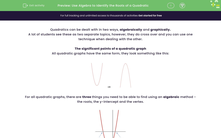Quadratics can be dealt with in two ways, algebraically and graphically.
A lot of students see these as two separate topics, however, they do cross over and you can use one technique when dealing with the other.
The significant points of a quadratic graph
All quadratic graphs have the same form, they look something like this:
For all quadratic graphs, there are three things you need to be able to find using an algebraic method - the roots, the y-intercept and the vertex.

In this worksheet, we’re going to look at how we find the roots algebraically.
Example:
How to find the roots of the quadratic y = x2 + 3x - 4
This is actually much simpler than you might think.
We need to think what is important about the two points on the graph above that are labelled root 1 and root 2.
They’re on the x–axis which means that the value of y for each of the roots is y = 0
So let’s look at what that gives us:
Step 1: Replace y with zero
This gives the quadratic equation 0 = x2 + 3x – 4 which can be rearranged to x2 + 3x – 4 = 0. (Does this look familiar? It should!)
Step 2: Factorise the quadratic
You should be able to do this one quite easily:
x2 + 3x – 4 = 0 → (x + 4)(x - 1) = 0
Step 3: Solve the quadratic
For (x + 4)(x - 1) = 0, we can create two equations:
x + 4 = 0 → x = -4
x – 1 = 0 → x = 1
So the roots for the quadratic are x = -4 and x = 1
It's that simple! Let's have a go at some questions now.









